January 2019

Intro I had a Rickenbacker 4001 back in the day. It belonged to my friend, John. He wasn’t in a band at the time and sold it to me for $400! That must have been around 1995 or so. In 1998, John and I were in a band and he was the bass player so I asked him if he wanted to buy back the Rick or trade it for a nifty Ensoniq SQ-1 Plus 32 keyboard since I figured he might actually use the bass now. We ended up trading and I still have the keyboard and he still has the bass. We have an understanding that neither of us can sell it, otherwise we’ll have to trade back. With the way prices of Rickenbacker basses are these days, I doubt he’ll ever sell it and I doubt I won’t let him forget that!
Fast forward to December 2018. Someone I know recently purchased a Les Paul guitar copy from China, aliexpress.com to be exact. He said it arrived in impeccable condition, beautifully done and for UNDER $200! I was intrigued so I started looking for basses and found that I could have a Rick 4001/3 copy made for less than $300!
Ordering The colors and styles of instruments is astounding! Just about every color you can think of from the basic black Jetglo to a natural Mapleglo finish and a few different sunbursts, a beautiful blue Azureglo. Of course these are sub $1000 instruments, hell, they’re sub $300, so you have to wonder what it’s going to look like and most of all what it’s going to sound and play like!
 I chose a white Rick 4001/3 with black hardware and dual outputs (Rick-O-Sound on real Ric instruments) from J Harden Aliexpress store. One thing that bugs me is that the builders are making counterfeits. The markings on the instruments they build have the logo of the brand they’re ripping off. It would be fine if they shipped the bass with a blank truss rod cover or gave me an option of leaving it off. When mine arrives, I will be de-badging it and putting on a custom truss rod cover, most likely one that says Rickenfaker.
I chose a white Rick 4001/3 with black hardware and dual outputs (Rick-O-Sound on real Ric instruments) from J Harden Aliexpress store. One thing that bugs me is that the builders are making counterfeits. The markings on the instruments they build have the logo of the brand they’re ripping off. It would be fine if they shipped the bass with a blank truss rod cover or gave me an option of leaving it off. When mine arrives, I will be de-badging it and putting on a custom truss rod cover, most likely one that says Rickenfaker.
Shipping and Waiting If you’re like me, online tracking of a shipment is both a blessing and a curse. You can see (mostly) up to date progress of your shipment, where it is in the world, when it’s expected to arrive, etc. The downside of course is the waiting and wondering something like “Why the hell is it stuck at the Post Office 100 miles from my house!?” Like watching a pot and expecting it to boil, watching the online progress of your package in the hands of UPS, FedEx or the USPS can be brutal.
I ordered my bass on December 26th and it didn’t ship until January 7th. On January 3rd, I received a message from the seller saying that they didn’t have the “black accessories in stock” and would it be okay if they swapped out “white” (I’m assuming he meant chrome). Uhhh, no. I wanted all black hardware. Now my mind was racing. Should I have ordered a different color scheme? I sent him a message and asked him if he had other color options to choose from. The Azureglo (blue burst) looks nice…
A long, well it was long for me anyway, weekend went by and on the 7th I received a message saying they had the black accessories in stock. A couple hours later I received a notification that my order was shipped!
 Aliexpress has a page where customers can see their order status as well as shipping status once the shipping label has been created. “Shipment ready for dispatch” is the status I saw for the next 10 days. Ugh! Much like the watched pot, my shipment status never changed. “”Shipment ready for dispatch.” The next day: “Shipment ready for dispatch.” I told myself I’d wait a couple of days in between checking the shipping status…that ended up lasting about an hour. “Shipment ready for dispatch.”
Aliexpress has a page where customers can see their order status as well as shipping status once the shipping label has been created. “Shipment ready for dispatch” is the status I saw for the next 10 days. Ugh! Much like the watched pot, my shipment status never changed. “”Shipment ready for dispatch.” The next day: “Shipment ready for dispatch.” I told myself I’d wait a couple of days in between checking the shipping status…that ended up lasting about an hour. “Shipment ready for dispatch.”
A few of things had me worried. First, there was the US Government shutdown in progress, non-essential government workers were furloughed basically because of politics. Some workers were not being payed for the work they were doing, and some were not on the job at all. Is this going to affect my shipping time?
The next thing on my mind was once it got to the US, will my bass be stuck in the Customs pile for weeks on end until the furlough is lifted? Will some disgruntled US Customs worker see my Rickenfaker and seize it because it’s a blatant instrument forgery? You know how Rickenbacker is about their trademark shapes and logo. If you don’t know, Rickenbacker International Corporation (RIC) regularly stop eBay auctions of Rickenbacker guitar and bass copies when their name is mentioned in the auction, even if the guitar was made in the 1970s! They seem to be the most active instrument company that is keeping their trademarks protected. Some people applaud them for keeping such stringent tabs on their trademarks and others think they are being a bit over protective. What if my bass was seized because of this?! I’ve heard of it happening. Lastly, according to my shipping notification, orders might be delayed because of the Christmas shopping rush. Great, one more thing to worry about.
Arrival My morning ritual lately consists of making my coffee and breakfast, feeding the cats, checking my Aliexpress shipping status…in that order…well, usually. On the morning of January 16th, the status has changed to “UNITED STATES OF AMERICA- Released from customs”! It was in San Francisco!!!! Now how long is it going to be stuck there? A few hours later, I get a notification saying it was at a local Post Office near San Francisco, most likely being readied for the cross country trek to New England where I live. I figured it would get here in a four days or so, especially since it was a long weekend and government offices are closed for Civil Rights Day on Monday.
The next morning, I get a notification that it’s “On vehicle for delivery!” Is that not the best status to see? Well, it can be. What if no one is home?! Crap. Then I’ll have to wait another day. I sign up for text notifications, again a blessing and a curse and hope that someone is home when the post man cometh.

Around 1:30, I get a notification from our home security camera that someone’s at the door. It’s the mail carrier attempting to deliver my bass, and no one is home! My wife gets home five minutes later and finds the receipt from USPS saying they tried to deliver but no one was home. According to the slip of paper, I can have them try again tomorrow. That wasn’t good enough for me so I stopped by out local post office to see if I could pick it up. We live in a very small town, so a nearby, larger town’s post office delivers our mail and I found out my bass was at that town’s post office. I hopped in my car and raced down to see if I could intercept it.

Unboxing Yellow packing tape covering a styrofoam case made my parcel look like a big wedge of cheddar cheese. I was pleasantly surprised to see it wasn’t damaged in the 6,954 mile journey. Carefully I cut open the package and since I didn’t opt for a hardshell case, my bass looked like it was entombed in white styrofoam, and little flakes of the stuff would haunt me over the next several days. The bass was nicely wrapped in a polystyrene bag, and fit snugly into the shipping box. It also included a set of four Allen wrenches, and a signal cable (1/4″ jack guitar cable), which I quickly put to use, plugging it into my tuner then into my trusty 1981 Carvin X-100 tube amp for a first test drive.
Fit and Finish The overall craftsmanship on the bass is pretty good. Definitely better than I expected. The binding around the bass was painted on, fair enough. I guess I can’t be too choosy about that since I paid $281 for it. Paint was nicely done except for some orange peel at the top of the headstock–barely noticeable and the binding stripe is a bit faded or worn on the knee cut.
The black hardware does make the bass pop with the white paint, it does look pretty nice for the most part, but I don’t think I’ll ever buy another instrument with black hardware. The amount of scratches on it within just a couple of days is agrivating–certainly not the fault of the builder. And speaking of black hardware, the seller did say that at one point they were out of some of the black hardware and asked me if I wouldn’t mind if they substituted some pieces in chrome. When I said I’d prefer all black hardware, they said they had some black hardware arrive.
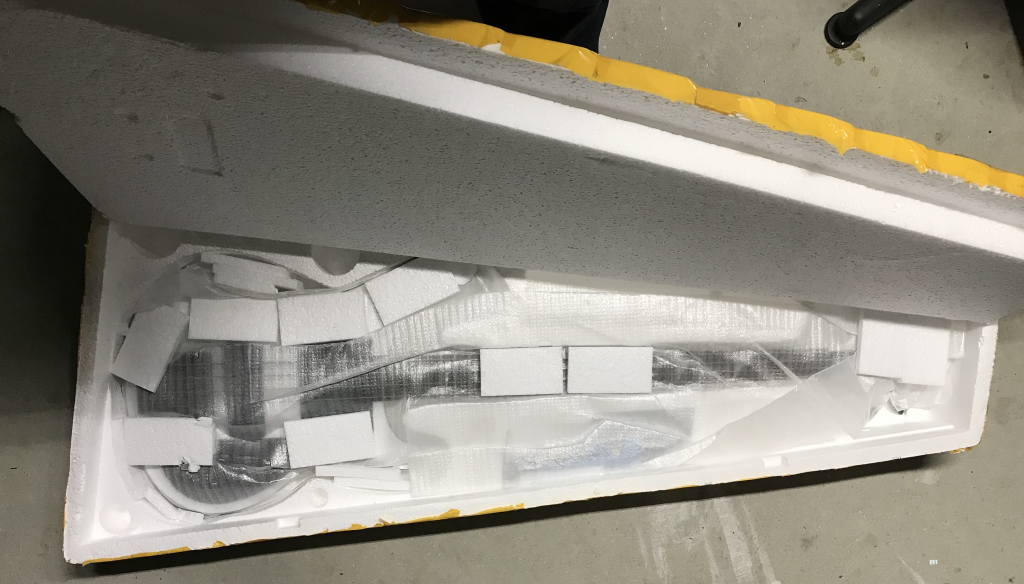
Styrofoam sarcophagus 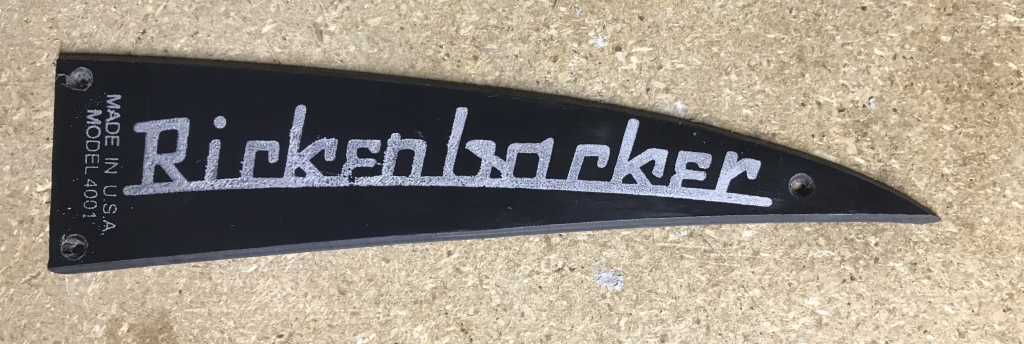
Truss rod cover (TRC). 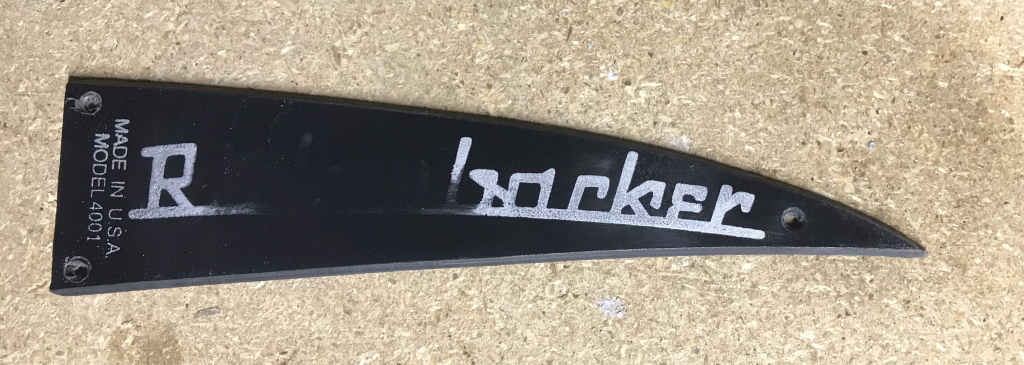
After a bit of rubbing off with denatured alcohol. 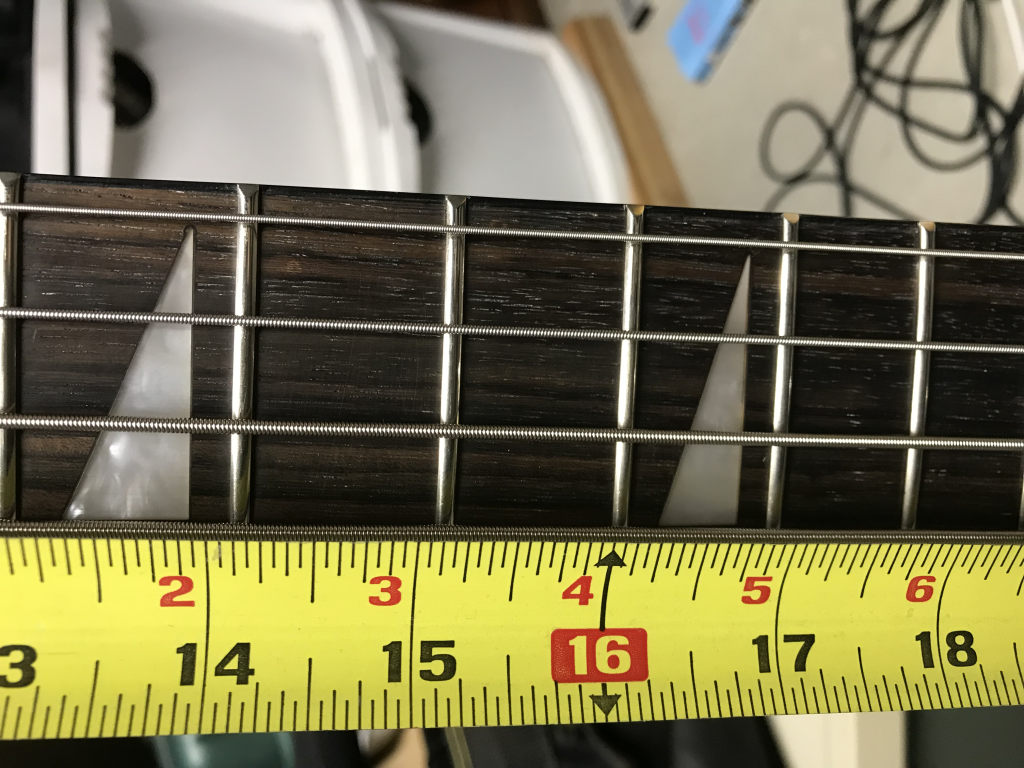
The 12th fret lies at 17″, so that measurement x2 means the scale length is 34″. 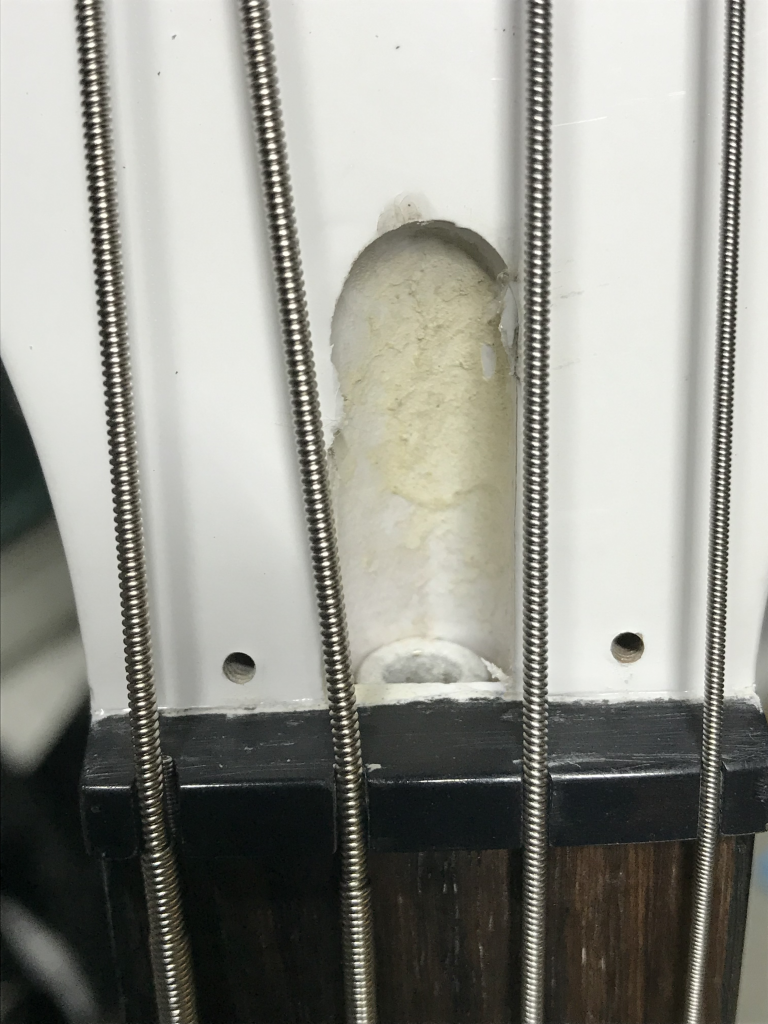
Single truss rod, strings sitting in nut
Click a caption for more detail.
I mention this because one of the first things I did was remove the bridge pickup cover and noticed that had not been powder coated, but rather painted. The switch ring was also painted and I’m sure if I look closely enough there is probably something else that was painted instead of powder coated as well. There are a few other things that I found cheesy (no pun intended from the block of cheddar remark earlier).
Playing and adjusting The bridge is the biggest issue for me. I read on an online forum that using a real Rickenbacker bridge or an aftermarket bridge made for a Rick bass of this style won’t work because theses basses are 34″ scale length and a real RIC bass is a weird 33.25″ scale. Intonation with the stock bridge is a pain because the saddles are not screw adjustable, but rather are stuck into the grooves of the bridge and you have to tap the saddle toward or away from the neck instead of twisting a screw to do this. On top of the saddles, the strings rest on a barrel-shaped piece, which fall off or into the pickup cavity I learned as soon as you take a string off. Adjusting this particular bridge was double frustrating to me because of minding not to scratch the black hardware, more on this later. It is height adjustable with an Allen wrench, but not one of the ones they gave me. Funny thing about those Allen wrenches that they included, only one actually fits something on the bass–the one for the truss rod.
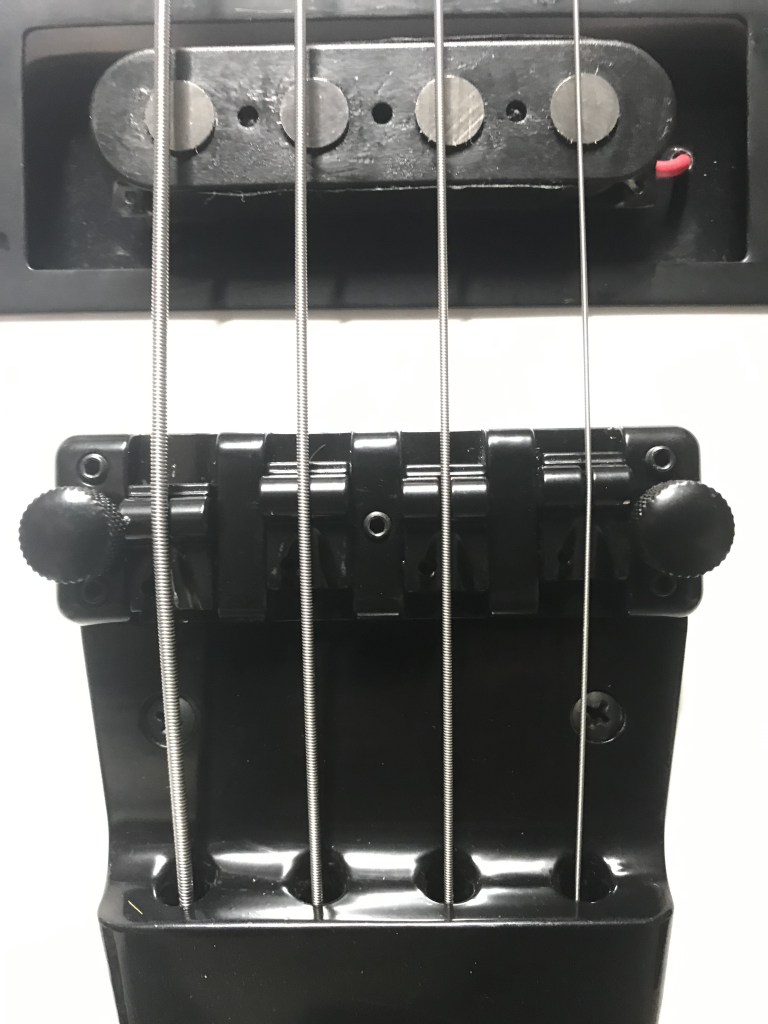 The truss rod cover (TRC), baring the Rickenbacker logo and the words “Model 4001” and “Made in USA” were crudely painted on, not engraved like real RICs. If you zoom into the photos of the TRC, you can see the cheesiness of that. When I removed the TRC, which is just black plastic pickguard material, I found I could take the painted logo and wording off. The lettering came off using a rag and some denatured alcohol, so for now I’m sticking with black. Under the cover, I noticed there was a single truss rod, unlike a real RIC bass which has two.
The truss rod cover (TRC), baring the Rickenbacker logo and the words “Model 4001” and “Made in USA” were crudely painted on, not engraved like real RICs. If you zoom into the photos of the TRC, you can see the cheesiness of that. When I removed the TRC, which is just black plastic pickguard material, I found I could take the painted logo and wording off. The lettering came off using a rag and some denatured alcohol, so for now I’m sticking with black. Under the cover, I noticed there was a single truss rod, unlike a real RIC bass which has two.
The 4th and 5th frets were a little high after I lowered the action and swapped the strings. Because I like low string action, I had to level then polish all the frets and now it plays great. I’m very happy with how it plays, but the silk ends hanging over the nut into the first fret bugs the hell out of me. I do have a non-Ric style bridge on order and hopefully that works out for me.
Wiring One of the other things that I found confusing is the wiring. I’m not sure if the builders don’t understand the benefit of Rick-O-Sound or if they somehow couldn’t replicate it. I believe this bass is wired similarly to a Les Paul guitar, but in this case it has two outputs. They seem to output the same signal and both jacks are mono instead of one being a switchable stereo (tip, ring, sleeve) jack. I’ll have to tackle that later if I decide to mod the electronics at all. The pickups don’t sound horrible, but definitely a bit nasally if you’ve got both pickup volumes cranked all the way up. On most basses that I own that have a pickup in the neck position and the bridge position, I usually turn down the neck volume to about 7/10 and keep the bridge volume at 10. For this bass, I was able to get a nice tone doing this.
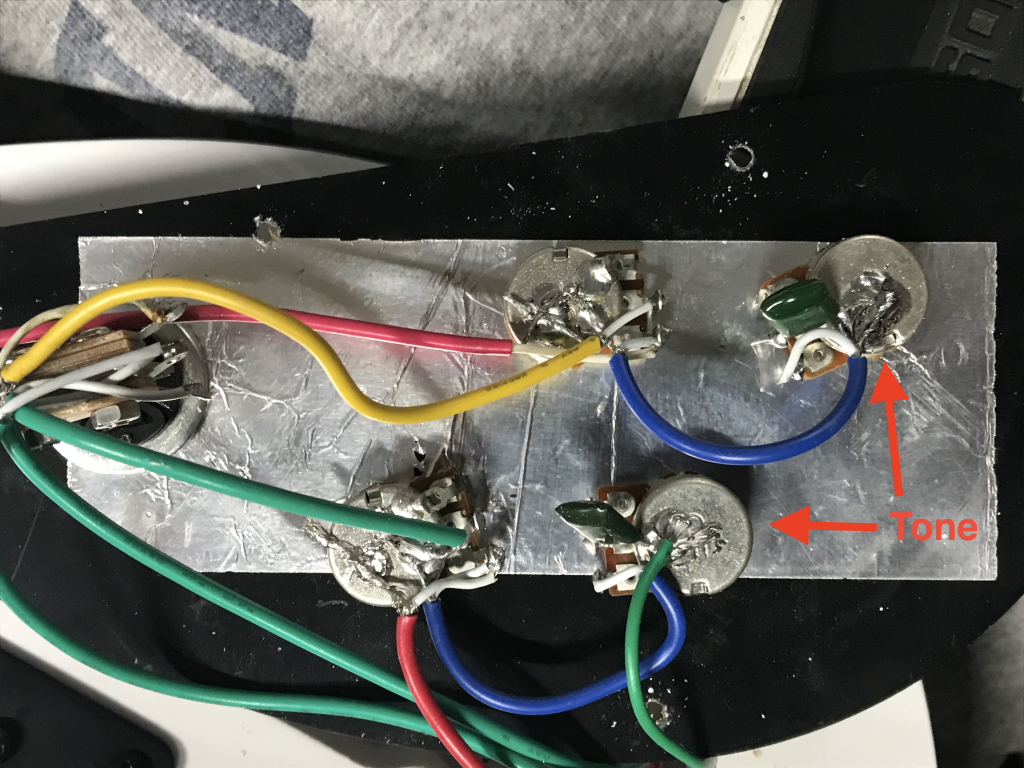
When I took the pickguard off to inspect the wiring and to install some shielding tape to the cavities, the flakes of styrofoam permeated even in there. I had to use my vacuum to get all of them out and some of them were statically charged and wouldn’t budge without the help of the sticky side of some masking tape.
Conclusion Overall I am very happy with the bass, but the bridge is my biggest complaint. Like I mentioned, the pickups aren’t horrible, and they sound good for now anyway. The paint is decent and when you factor in the cost of shipping from China, this bass is a great value. I don’t think Rickenbaker is ever going to produce a value line of instruments such as Squier or Epiphone, so if you want the Rickenbaker look without the price, look no further. Just make sure you buy from a seller with good feedback. There are plenty with good feedback and plenty with bad or less than good feedback. I would do business again with J Harden Store. With the increasing price of the Japanese Rickenfakers these days, you can’t beat the price of a Chinese made one, even if you need to make some modifications to get it the way you want it.
Update, February 21, 2020.
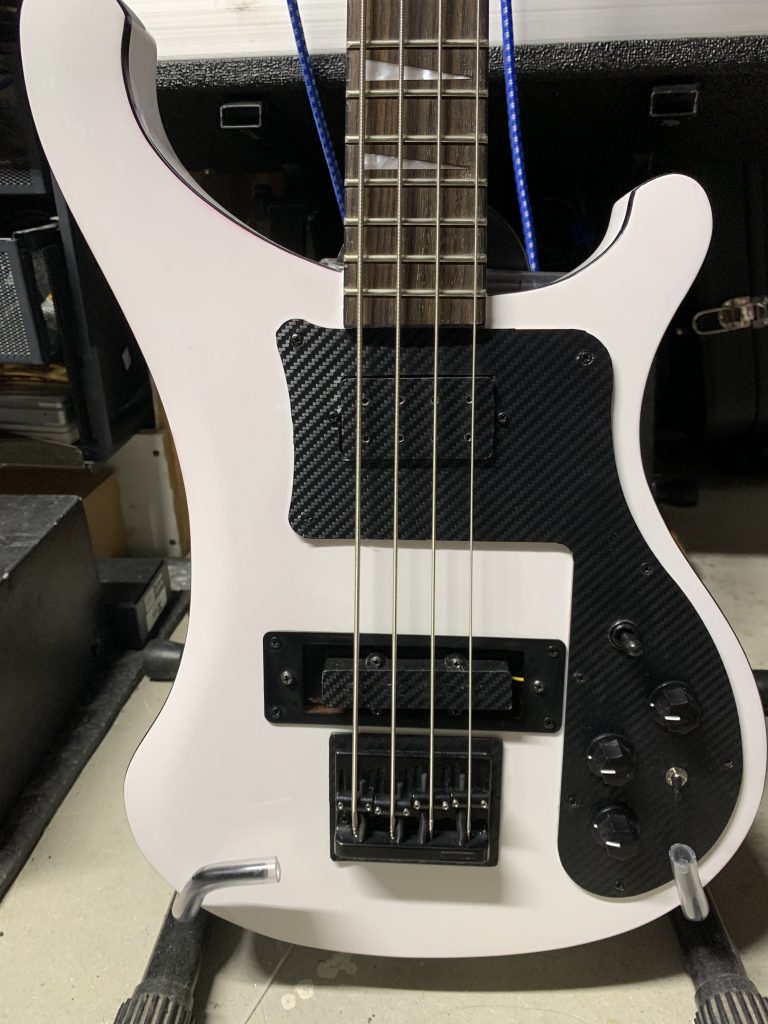
Since then, I have upgraded a few things. Before any of these mods, I replaced the bridge with a Gotoh 201 bridge and a piece of pickguard material underneath to cover up the nasty hole that the original bridge needs. That alone made a huge difference in tunability and intonation.
After taking the bass on a heavy gig schedule for the last year, I have been slowly replacing other hardware on it. It has been my 1/2 step down bass, so I used it about 1/3 of the time during a show.
The first to go was the pickups. I had a couple extra pickups from various projects in the parts drawer. For the neck pickup, used a Schaller Bassbucker and did a coil split switch in replacement of the tone pot–which I never, ever use. For the bridge pickup, I had a MIM Fender Jazz pickup and put that in there. I also ended up shielding under the pickguard and inside all of the cavities. It’s better than before. I really like the neck pickup, but the bridge pickup is a bit lacking. Maybe a hotter pickup next time.
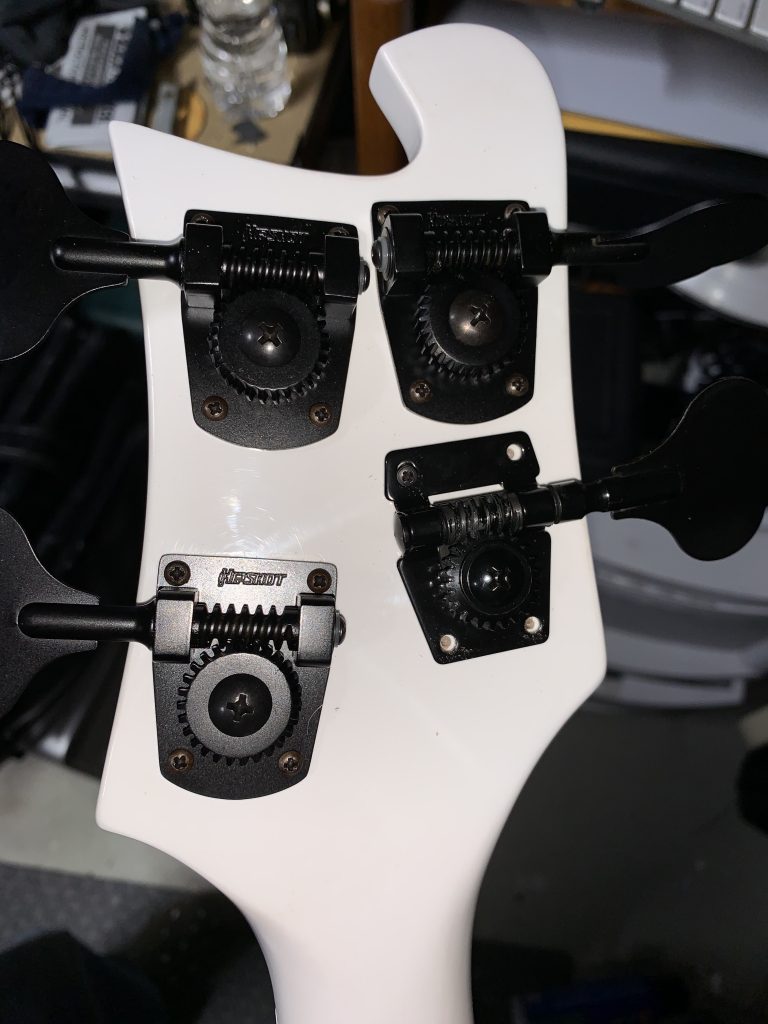
Another thing I ended up doing is covering the pickguard and truss rod cover with some carbon-fiber looking vinyl. It really makes it look much nicer I think. While on the headstock, I upgraded the tuners to four Hipshot HB7 tuners. At first I was going to put a Hipshot Xtender on the E string (or Eb in this case) but it was too big for the space on the headstock and I had to return it. If I went with their ultralight tuners maybe those would have fit with an Xtender. I stuck with the HB7 because they were the same size post hole and similar design. I did have to fill the screw holes and drill new ones. One thing I will say about the screws on this bass is aside from the pickguard screws, they are the cheapest, crappiest screws. So upgrade those screws as soon as you can.
Other than that, I did end up doing a full fret level and dress on the bass as well as tweak the truss rod a bit a couple of times. The frets are really cheap and I bet I’ll have to replace them soon. We have a 100 degree Fahrenheit swing from Winter to Summer here in New England, so setting up instruments is something I have been accustomed to doing regularly.